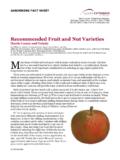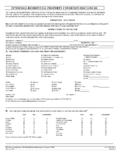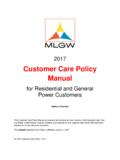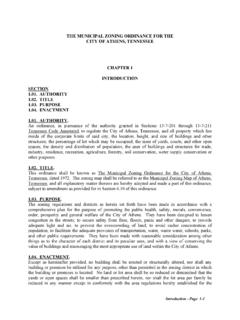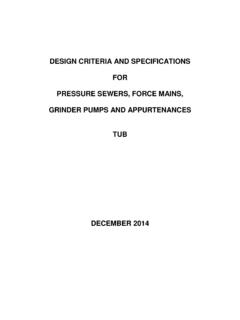Transcription of Tree Owner’s Rights and Responsibilities
1 Tree owner s Rights and ResponsibilitiesSP687 Larry Tankersley Extension ForesterForestry, Wildlife & FisheriesPhoto Credit: Wayne ClatterbuckMany of us own trees as part of our real estate. This endows us with certain Rights associated with those trees. Tree ownership also requires certain duties on our part to prevent our trees from becoming a nuisance or a liability. The objective of this publica-tion is to reduce misunderstandings among neighbors regarding their Tree?How do we know whether it s our tree? It is your tree if you planted it or if a previous owner planted it and its main trunk is entirely within your property boundary.
2 Naturally occurring trees are also generally the responsibility of the owner of the land on which they grow. The level of responsibility is determined by the context. A tree growing in a residential neighborhood would require more duty of care than a tree in a more rural setting. Boundary trees are those located on a common boundary line of adjoining landowners. Boundary trees are owned by both landowners as tenants in common. Each landowner whose land contains any part of a tree trunk has an interest in that tree. Trees located completely on one person s property can be considered a boundary tree if the adjacent owners have treated it as common property by express agreement or by their course of conduct.
3 Nei-ther owner is at liberty to remove the tree without the consent of the other, nor to cut away the part that extends into his/her land, if injury would result in harm to the common property of the tree. Adjoining LandownersWhether the tree is causing damage or not, if its branches extend beyond your property line, your neighbor has the right to trim your tree to the property line. Landownership Rights extend indefinitely upward and down and those Rights are protected from invasion by an adjoining landowner to the same extent as surface Rights . In trimming the tree, your neighbor is not allowed to unduly harm your tree, however.
4 This common law concept follows to a self-help rul-ing by most courts to limit lawsuits brought over trees. The rule requires that an adjoining property owner over whose property the branches overhang must use self help as the remedy rather than require the courts to intervene in such matters. The court held that no landowner has a cause of action from the mere fact that the branches from a healthy and innocuous tree belonging to an adjoining landowner overhang his/her premises. His/her right to cut off the overhanging branches is considered a sufficient remedy.
5 Notice is not required (but might be encouraged).As a general rule, a landowner has no natural right to air, light or an unobstructed view. It has been held that such a right may be created by private parties through the granting of an easement or through the adoption of conditions, covenants and restrictions, or by the legislature by creating a right to sunlight for solar col-lectors or for satellite television. Local governments may impose restrictions that pertain to the property as to obstructions to air, light and view. A large tree overhanging two adjacent properties between two drivesTree owner RightsOur Rights associated with trees limit nuisance claims and trespass with regard to cutting, trimming or removing trees that extend beyond property boundaries, especially abutting easements for streets and utility lines.
6 According to the trespass law, others are not allowed to harm our trees. Persons cutting, removing or otherwise harming our trees can be liable for double or triple the value of the tree if trespass is upheld. Typically, the most contentious trespass is tree trimming or right-of-way maintenance by utilities or municipalities. In a tree trimming dispute with a utility or service, first determine whether the company has the authority to trim or remove trees. Persons using a right-of-way generally have no Rights unless granted by the jurisdiction s authority for proper use of the streets.
7 If authority exists, determine whether or not an easement is present on your property that would allow the public utility to enter the land. A landowner whose title extends to the center of the street has an interest in the trees adjacent to the public right-of-way. The authority of the utility to use the street does not empower or authorize it to damage the trees or otherwise appropriate any of the landowner s property without compensation. Contrast this situation to one where the municipality reserves the right to use your land for , the easement holder has the right to remove obstructions located within the scope of the easement that threaten the full use of that easement.
8 The easement holder likewise has a duty to remove those obstructions in a way that causes the least destruction to the landowner s property . This is accomplished by doing only what is reasonable and necessary to insure the easement holder s full enjoyment of the easement. Reasonable and necessary are often subjective parameters and depend on the facts and circumstances of each case. Tree trimming standards do exist for most situations. Many cases make it clear that a landowner s property interest in trees is subservient to a public utility company s right to remove and trim trees that interfere with the necessary and reasonable operation of the utility.
9 The right of the general public to receive the benefits public utilities provide supersedes the Rights of property owners to have trees located on their property untouched. Tree owner s ResponsibilityGenerally, the landowner on whose property a tree grows will be held to a duty of care, determined by principles of neg-ligence. Common prudence in tree maintenance is expected to prevent injury or damage to a neighbor s property . A landowner with constructive or actual knowledge of a patently defective condition of a tree is liable for damages, injury or death caused by that tree.
10 Knowledge of the condition is always difficult to determine. Some cases, however, have held landowners to a higher standard (greater duty) of inspection to discover pos-sible defective conditions of a tree to prevent the tree from causing problems. Tree owners in urban areas have a duty to inspect each and every tree on the premises to determine hazard trees and have them removed. In rural areas, there is no duty to inspect natural trees, but if you know or should have known hazardous trees exist, liability has held for natural trees in these are not typically liable for Acts of God.

